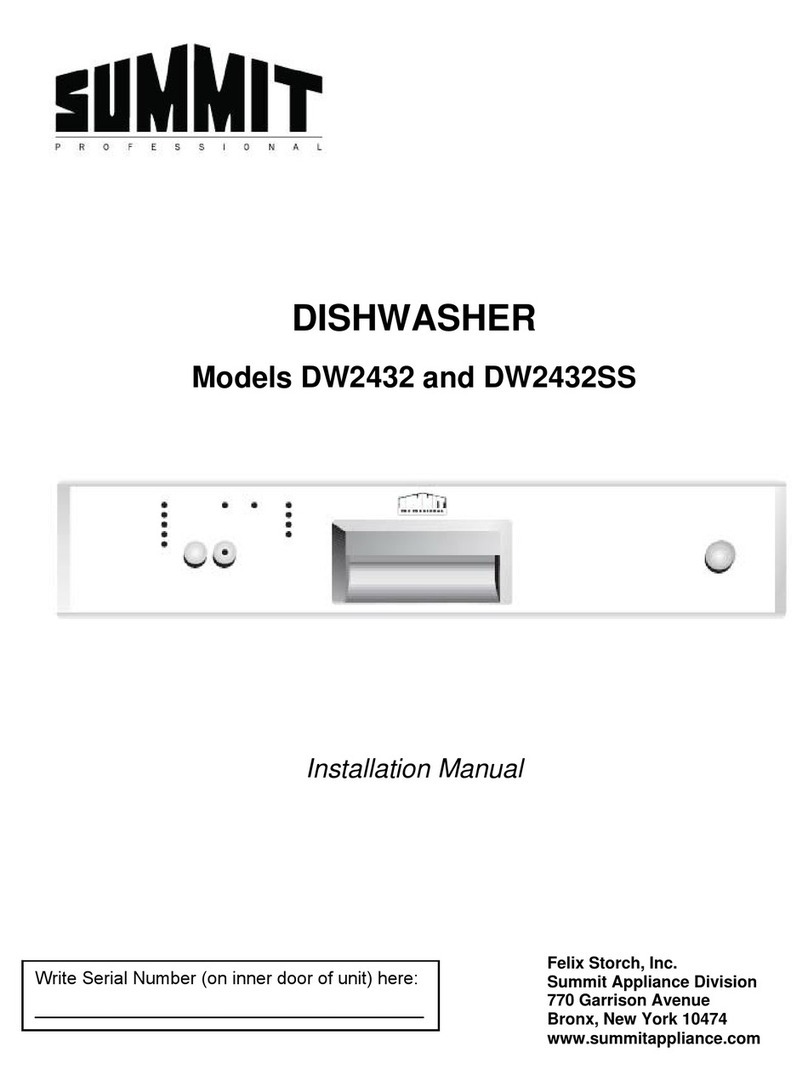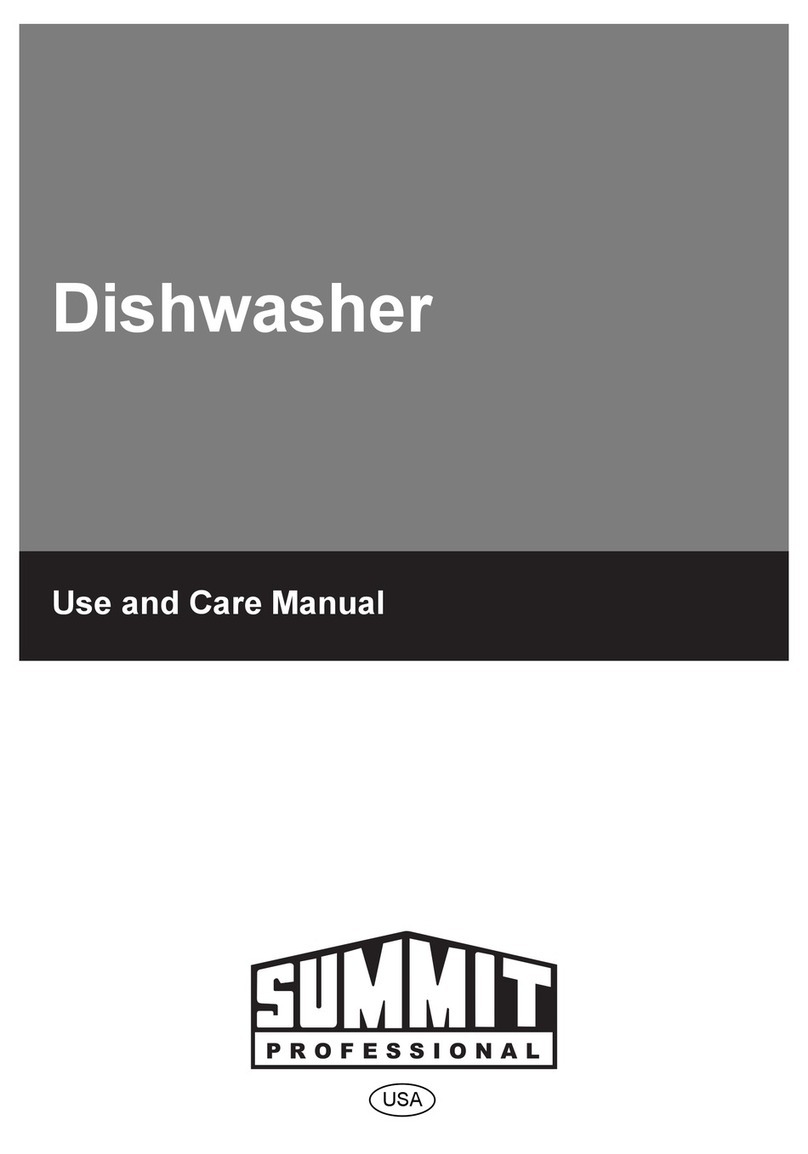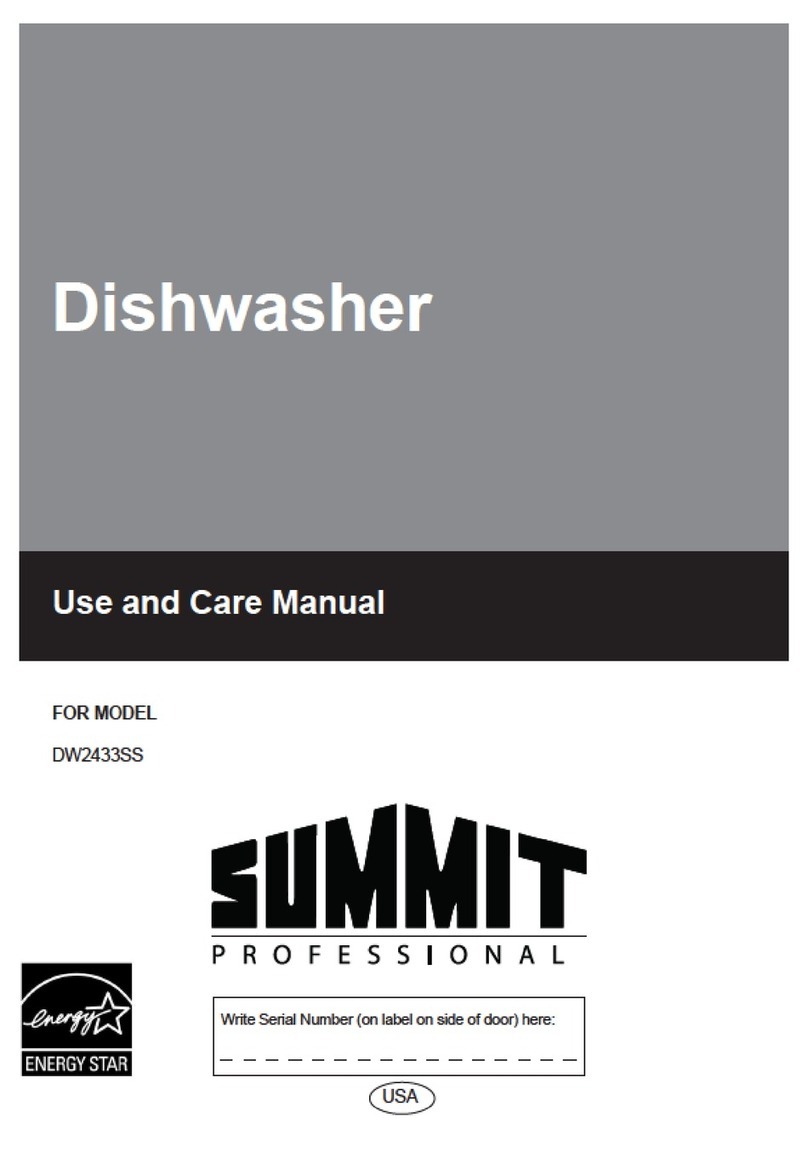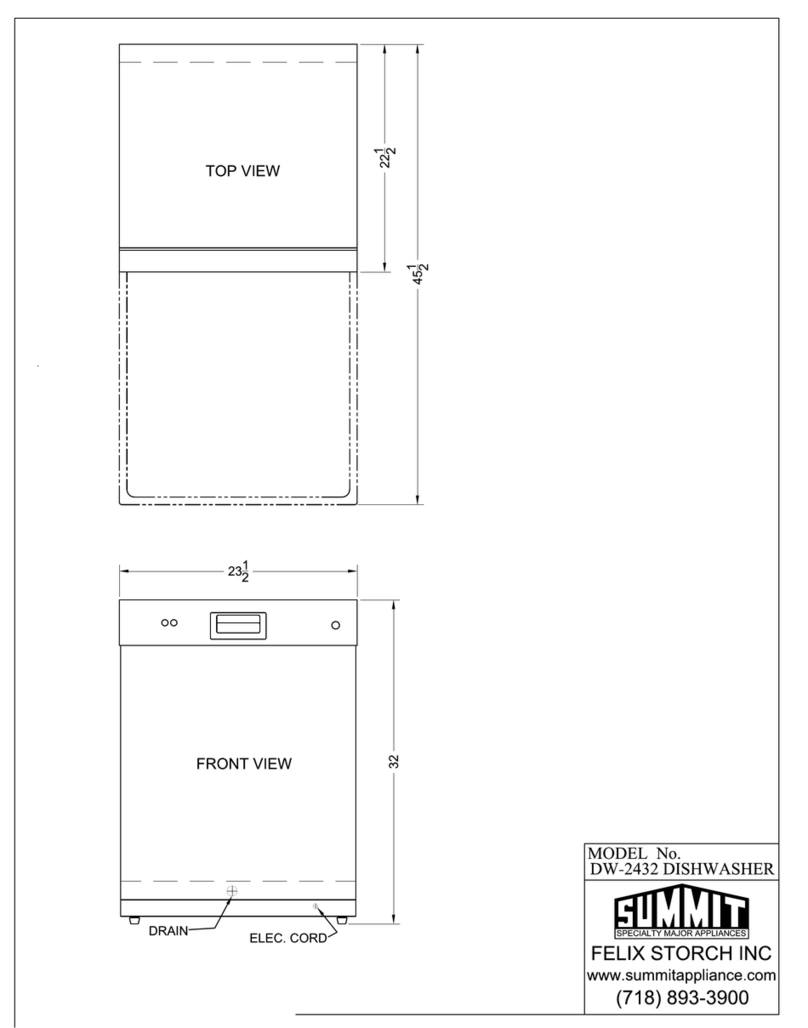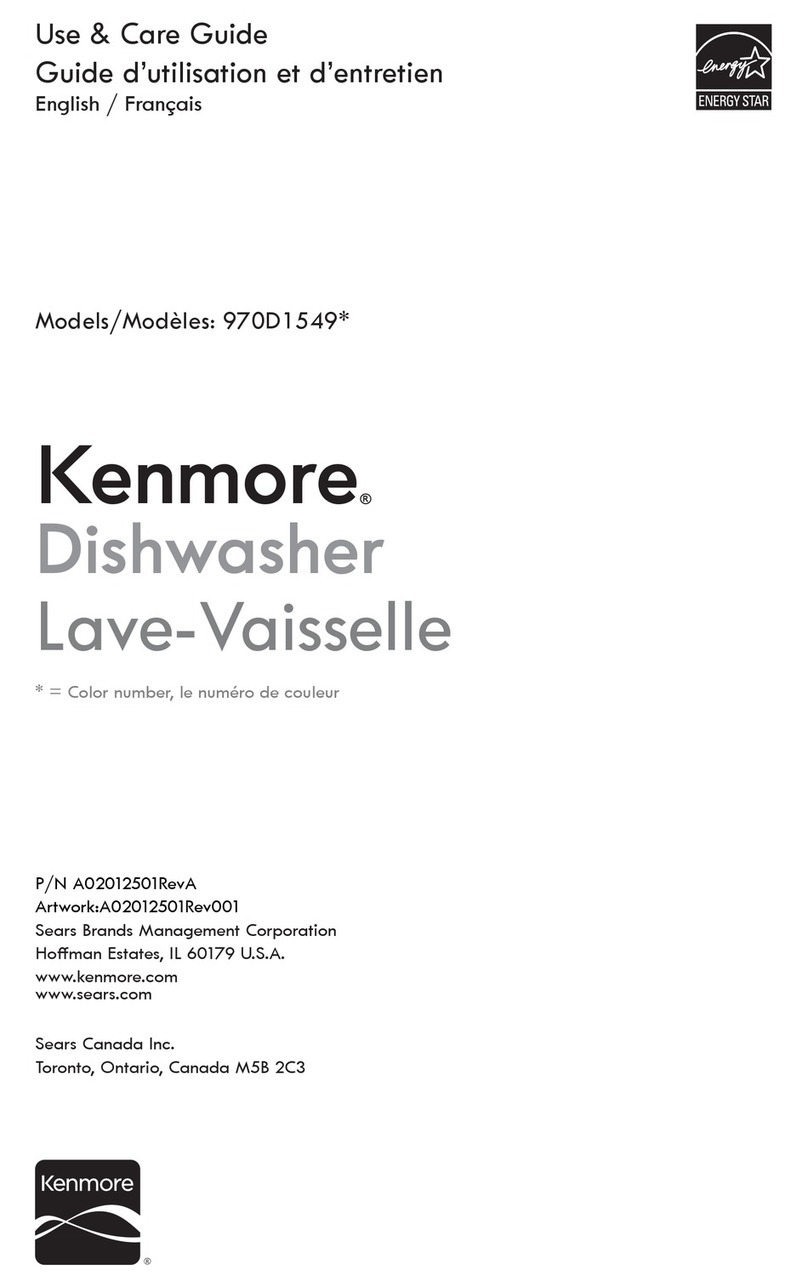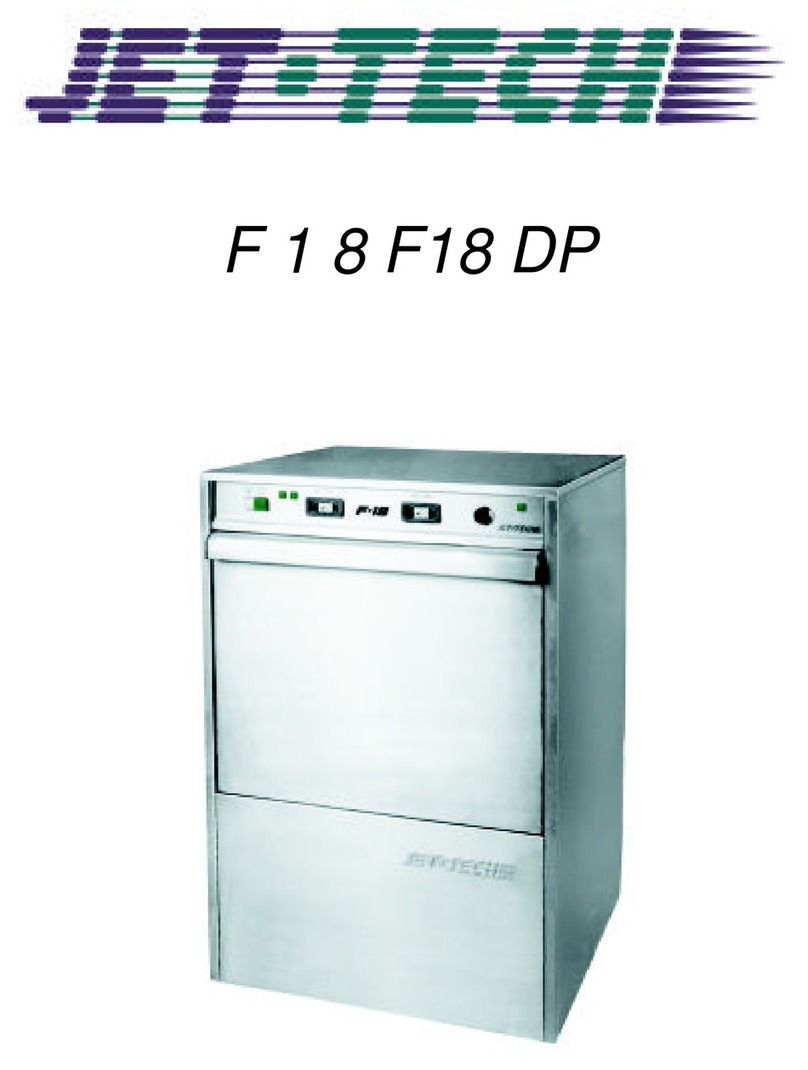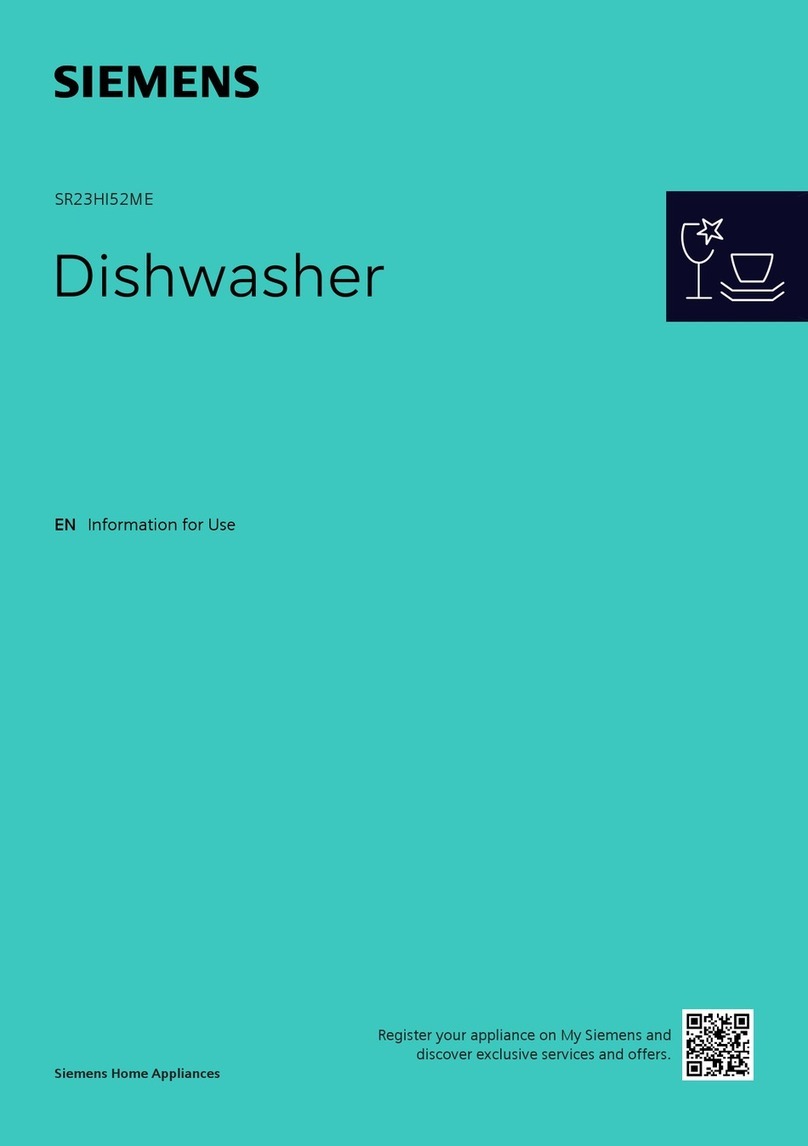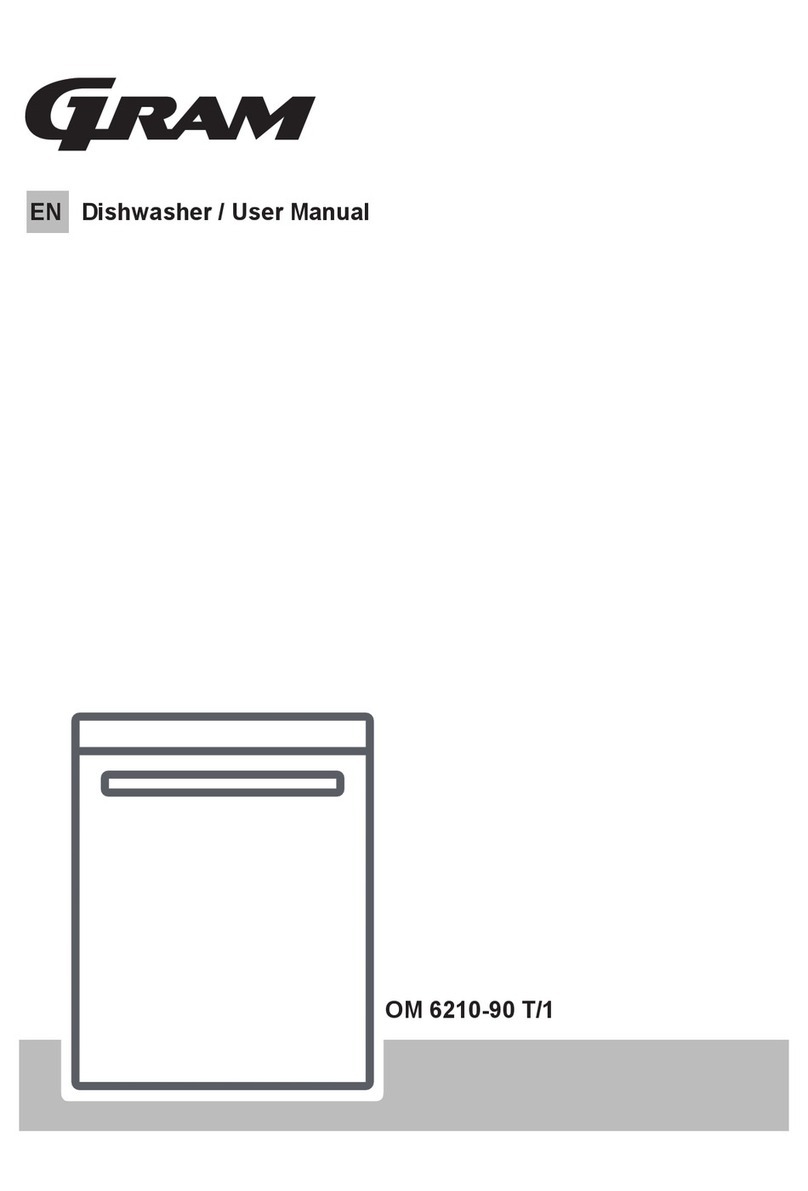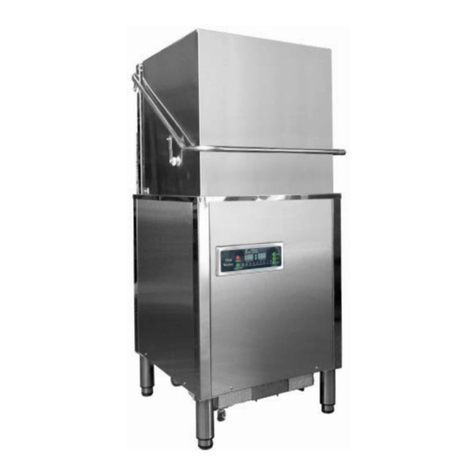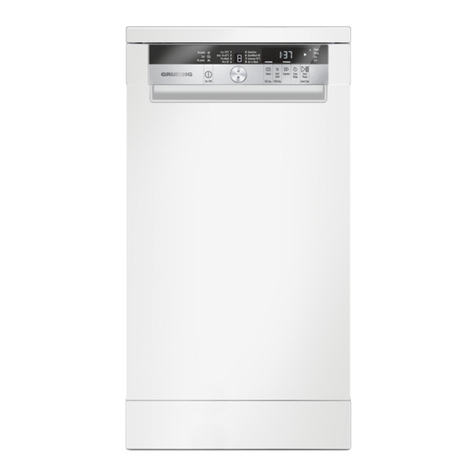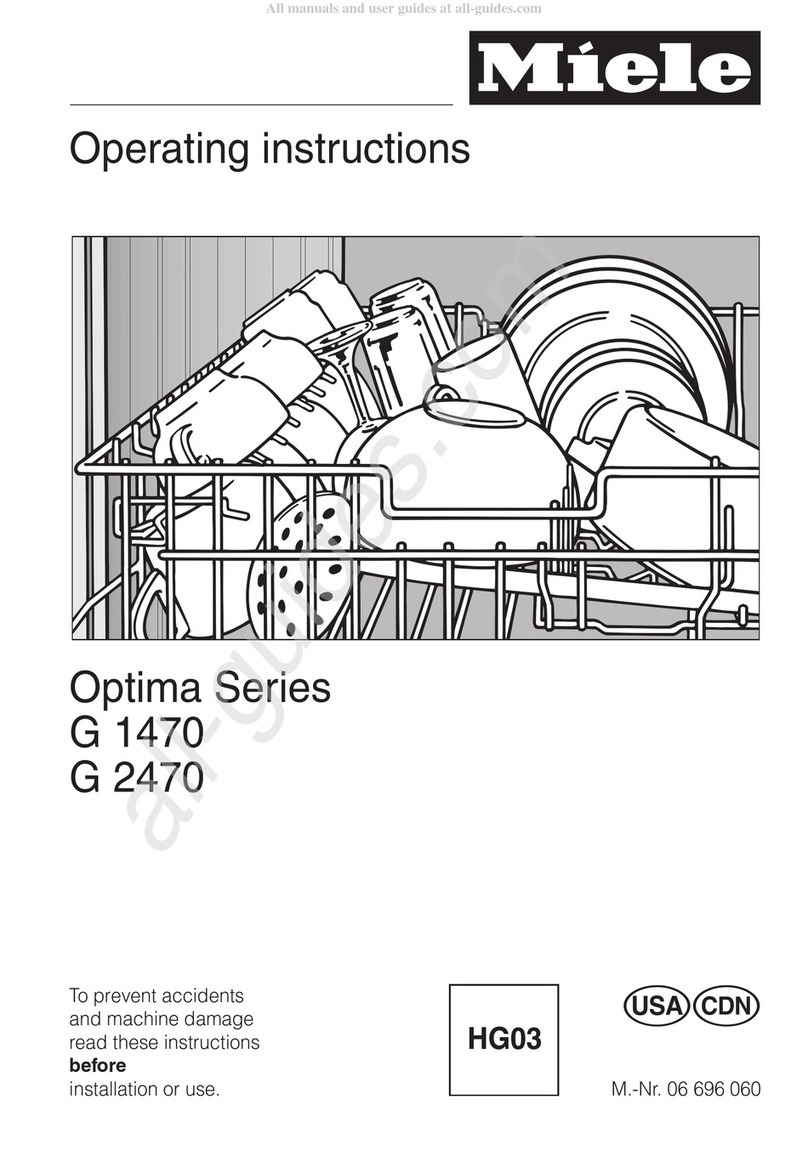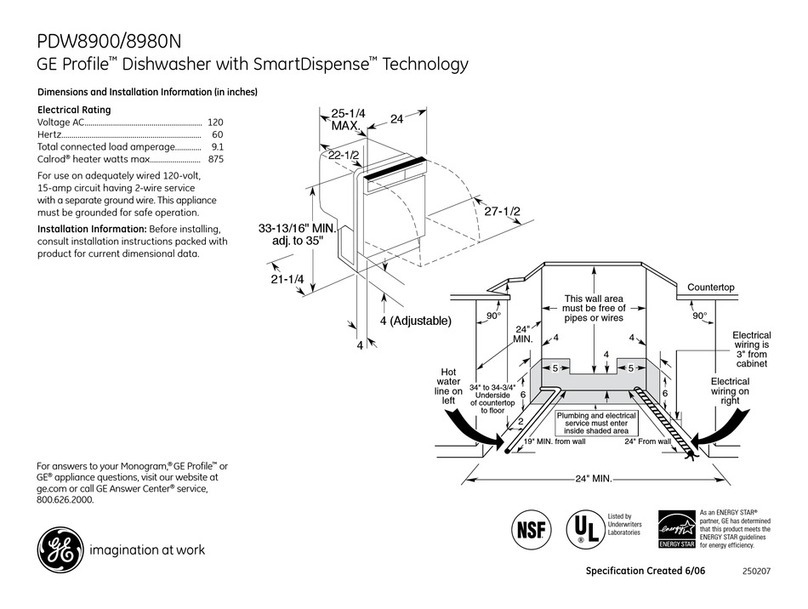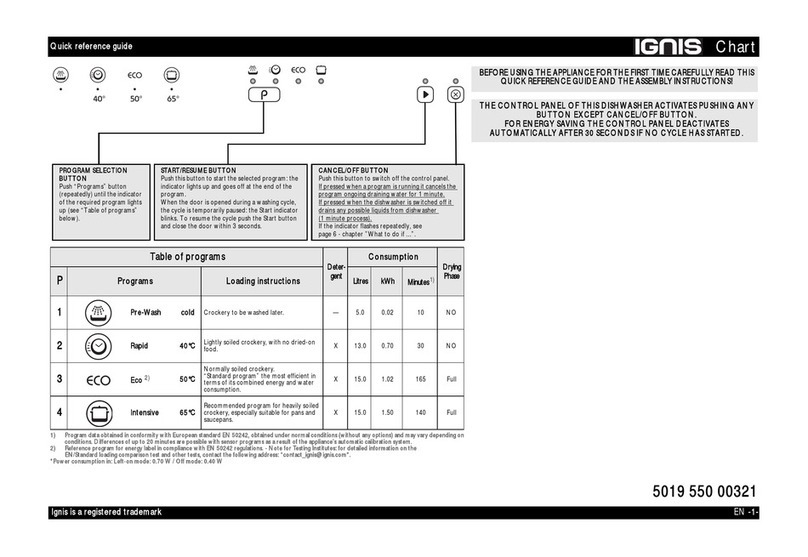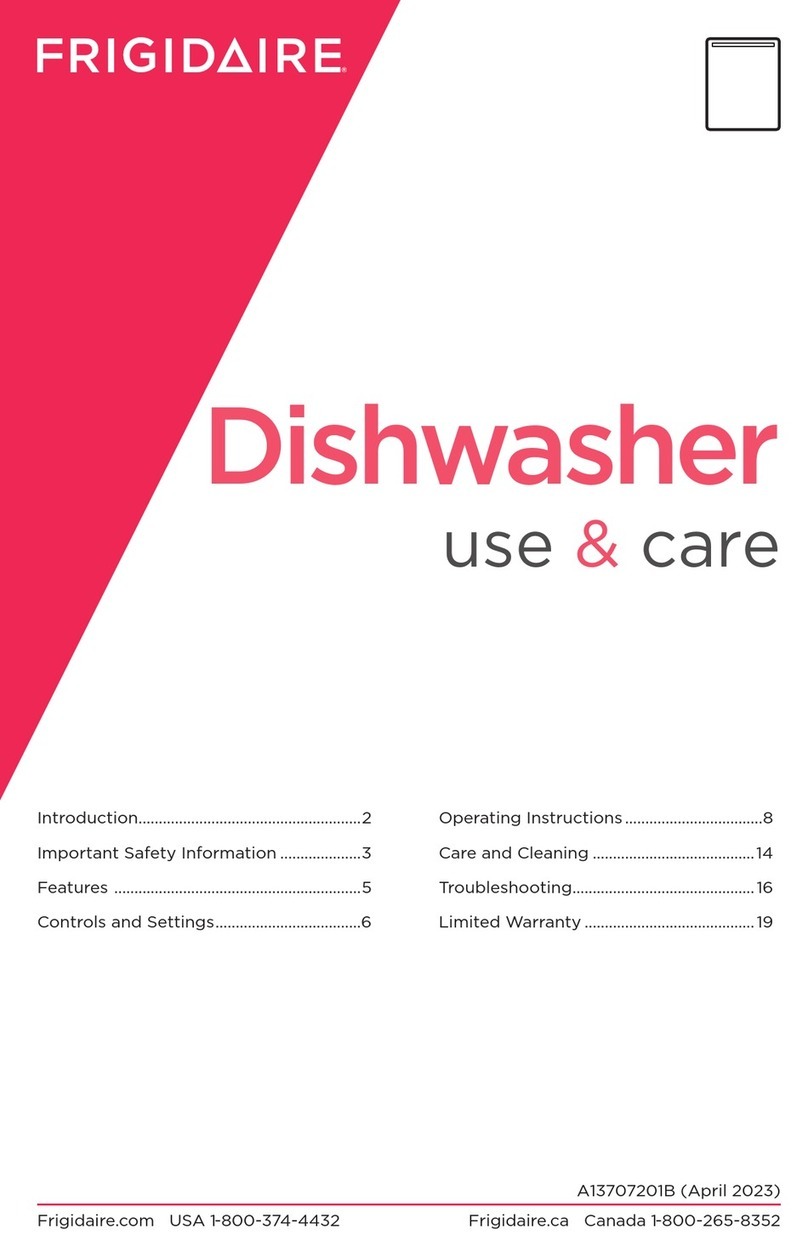Summit DW-2432 User manual

P R O F E S S I O N A L
Use and Care Manual
Dishwasher
FOR MODELS
DW2432
DW2432SS
USA

To prevent accidents, which could cause serious injury or death, as well as
machine damage read these instructions before installation and / or use.
Contents
1. IMPORTANT SAFETY INSTRUCTIONS 1
2. INSTALLATION 3
3. GETTING TO KNOW YOUR DISHWASHER 4
4. LOADING THE DISHWASHER 5
4.1 UPPER RACK 6
4.2 LOWER RACK 7
4.3 PROPER AND IMPROPER LOADING OF DISHWARE 10
5. WHAT SHOULD NOT BE WASHED IN YOUR DISHWASHER 11
6. OPERATING THE DISHWASHER 12
7. DETERGENT & RINSE AID DISPENSER 14
7.1 FILLING THE DETERGENT DISPENSER 14
7.2 FILLING RINSE AID DISPENSER 15
8. SETTING THE WATER SOFTENER 17
9. FILLING THE DISHWASHER SALT DISPENSER 18
10. CARE AND MAINTENANCE 19
10.1 CARING FOR YOUR DISHWASHER EXTERIOR 19
10.2 CARING FOR YOUR DISHWASHER INTERIOR 19
11. TROUBLE SHOOTING 21
12. TECHNICAL FEATURES 27
13. WARRANTY STATEMENT FOR THE SUMMIT DISHWASHERS 28

1USA
INTRODUCTION
Please read this user manual and
particularly the safety instructions
completely and carefully. They will save you
time and effort and help to ensure optimum
dishwasher performance.
Be sure to observe all listed warnings and
cautions. Look particularly for the icons with
exclamation marks inside. The information
icon will also provide important references.
1. IMPORTANT SAFETY
INSTRUCTIONS
WARNING
When using the dishwasher, follow
basic precautions, including the
following:
Read all instructions before using the
dishwasher! Save these operating
instructions and pass them on to any
future user.
Use the dishwasher only for its intended
purpose as described in this user
manual. This appliance is intended for
normal household use only.
• The manufacturer disclaims
responsibility for damage or injury
caused by improper use of this
appliance.
The information in this user manual must
be followed to minimize the risk of fire
or explosion and to prevent property
damage, personal injury or loss of life.
Do not operate your dishwasher unless
all the enclosure panels are properly in
place.
Do not tamper with the controls.
Do not abuse, sit on, stand in or on the
door or dish rack of the dishwasher.
The cup racks are designed to support
cups, glasses and kitchen utensils. When
the cup racks are in the dishwasher
do not lean on or use the cup racks to
support your body weight.
To reduce the risk of injury, do not
allow children to play in, on or near the
dishwasher.
Use only detergents or rinse aids
recommended for use in a household
dishwasher and keep them in a dry place
out of the reach of children. Check that
the detergent dispenser is empty after
the completion of each wash program.
Dishwasher detergents are alkaline.
They can be dangerous if inhaled or
swallowed. Avoid contact with skin
and eyes and keep children and infirm
persons away from the dishwasher
CAUTION
WARNING
ÝNotice
WARNING:
Indicates a potentially hazardous situation
which, if not avoided, could result in death
or serious injury.
CAUTION :
Indicates a potentially hazardous situation
which, if not avoided, may result in injury.
It may also be used to alert against unsafe
practices.
Notice :
Indicates a potentially hazardous situation
which, if not avoided, may result in damage
to the dishwasher, the table-ware, the
equipment or the environment.

2USA
when the door is opened. Consult a
doctor immediately if detergent has been
swallowed or inhaled.
Do not drink water from the dishwasher!
Harmful residues could be present.
Under certain conditions hydrogen gas
may be produced in a hot water heater
system that has not been used for
two weeks or more. Hydrogen gas is
explosive. If the hot water system has not
been used for such period, before using
the dishwasher turn on all hot water
taps and let the water flow from each for
several minutes. This will release any
accumulated hydrogen gas. As gas is
flammable, do not smoke or use an open
flame during this time.
Do not store or use flammable liquids or
vapors in the area of the dishwasher.
When loading items to be washed,
position sharp items so that they are
not likely to damage the door seal and
load sharp knives with the handles up to
reduce the risk of cut-type injuries.
Do not wash plastic items unless they
are marked “dishwasher safe” or the
equivalent. For plastic items not so
marked, check the manufacturer’s
recommendations.
If a malfunction occurs, switch off the
appliance and turn off the water supply to
the dishwasher.
Before cleaning or carrying out
maintenance, switch off the appliance,
disconnect the power plug and turn off
the water supply.
Repairs and technical modifications must
be carried out exclusively by a qualified
technician.
If the dishwasher is not in use for an
extended period of time (i.e. vacation
home), we recommend you check that
the baskets are empty, leave the inside
of the dishwasher clean, leave the door
cracked open to allow air to circulate and
turn off both the power and water supply
to the dishwasher.
SAVE THESE INSTRUCTIONS

3USA
2. INSTALLATION
WARNING
When installing the dishwasher, follow
basic precautions, including the
following:
The dishwasher installation must be
performed in accordance with the
installation manual. If you did not
receive an installation manual order it by
calling 1-800-287-8799 or you may also
download it from our web site at
www.summitappliances.com
Installation, maintenance and repair
should be performed by a qualified
installer. Work by unqualified persons
could be dangerous and may void the
warranty.
Do not operate the appliance if damaged,
malfunctioning, partially disassembled or
if it has missing or broken parts.
Before installation or service, disconnect
the power supply to the work area by
unplugging the unit, "tripping" the circuit
breaker or removing the fuse.
Only connect the dishwasher to the
power supply when all installation and
plumbing work is complete.
Do not install or store the dishwasher
where it can be exposed to below
freezing temperatures or exposed to
weather.
Dishwasher must be secured to adjacent
cabinetry using the brackets provided.
Failure to do this may cause damage to
property or bodily injury.
Connect to a properly rated, protected
and sized power supply circuit to avoid
electrical overload. The dishwasher is
designed for an electrical supply of 120 V
(volts), 60 Hz (hertz), AC, connected to a
dishwasher-dedicated, properly grounded
electrical circuit with a fuse or breakers
rated for 15 amperes. Electrical supply
conductors shall be a minimum of # 14
AWG copper wire rated at 75 °C (167
°F) or higher. These requirements must
be met to prevent injury and machine
damage. Consult a qualified electrician if
in doubt.
Do not use any extension cord or
portable outlet device to connect the
dishwasher to a power supply.
WARNING
Danger of suffocation!
Ensure that any plastic wrappings, bags,
small pieces etc. are disposed of safely
and kept out of the reach of children.
Remove the door to the washing
compartment when removing an old
dishwasher from service or discarding it.
Ensure that the appliance presents no
danger to children while being stored for
disposal.
Old appliances may contain materials
that can be recycled. Please contact
your local recycling authority about the
possibility of recycling these materials.

4USA
3. GETTING TO KNOW YOUR DISHWASHER
FOR MODELS
DW2432
DW2432SS
1. Upper rack
2. Guiding track for the upper rack
3. Upper spray arm
4. Lower rack
5. Salt container (depending on model )
6. Cutlery basket
7. Lower spray arm
8. Detergent dispenser
9. Filters
10. Door
11. Control panel
12. Model and Serial Tag
1
3
4
7
9
12
2
5
6
8
10
11
DWxxxxx xxxxx

5USA
4. LOADING THE
DISHWASHER
1. Pull the handle to open the door. If
the door is opened during operation, the
dishwasher will stop running. Once the
door is closed the program will continue.
Upper rack
DEPENDING ON MODEL
Top rack load pattern for 12 place
settings according to the AHAM
DW-1 Standards
CAUTION
Hot steam can escape! Danger of
serious burns or other injury.
2. Remove coarse food leftovers from
tableware.
3. Now you can load the dishwasher.
Lower rack
Bottom rack load pattern for 12
place settings according to the
AHAM DW-1 Standards
CAUTION
• Large knives and other utensils with
sharp tips and edges must be placed
horizontally into the upper rack due to
risk of injury. Other smaller knives and
sharp utensils should be placed with
sharp side down in the cutlery basket.
• Use extreme caution when removing
knives and other sharp utensils from
the dishwasher. These items may
have shifted position during the wash
program, and may be wet or slippery.
• The cup racks are designed to
support cups, glasses and kitchen
utensils. When the cup racks are in
the dishwasher do not lean on or use
the cup racks to support your body
weight.
Notice :
Your dishwasher holds a maximum of 12
place settings.
Place all containers such as cups,
glasses and pots into the dishwasher
with the opening facing downwards (so
that no water can collect).
Small and light items can go into the
upper rack.
Long and narrow items are placed in the
middle of the racks.
Place all large and very dirty items in the
lower rack.
Dishes and cutlery should not be placed
above each other.
Glasses should not touch.
The movement of the spray arms must
not be hindered.
Do not overload your dishwasher and
pay attention to manufacturer instructions
regarding dishes which are appropriate
for use in for a dishwasher. Only with
suitable dishes (mentioned in section 5)
will you obtain optimal washing results
with a sensible use of energy.

6USA
A
B
C
4.1 UPPER RACK
Load the upper rack with dessert plates,
cups, glasses etc.
4.1.1 HEIGHT SETTING
(DEPENDING ON MODEL)
In certain models, the height setting of
the upper rack may be changed using the
wheels which are present at two height
levels.
CAUTION
Make sure that the rack is empty.
Changing the height setting while the
rack contains tableware could cause the
contents to dislodge, causing personal
injury or damage to the tableware.
1. Release the latches on both the right
and left tracks of the upper rack by turning
them to the outside A.
2. Pull out the rack completely B.
3. Place the rack into the tracks again at
the desired height C.
4. Push the latches back into the correct
position.
4.1.2 VARIABLE HEIGHT SETTING
(DEPENDING ON MODEL)
The upper rack is equipped with a lifting
mechanism which enables you to change
the height of the rack even if it is fully
loaded, and without having to remove it
from the dishwasher.
LIFT UPPER RACK
1. To lift the upper rack to a higher position,
hold it on one side and carefully pull it
upwards A.
2. To lift the opposite side of the rack, hold
it and pull it upwards in the same manner.
A

7USA
B
AB
C
B
A
4.1.4 ADJUSTABLE SHELVES
(DEPENDING ON MODEL)
Depending on the size of the glasses
and cups, the shelf height setting may be
adjusted.
1. Fold the shelf upwards A.
2. Positioning at the desired height B.
3. Fold the shelf again downwards C.
LOWER UPPER RACK
1. To lower the upper rack, hold and press
in the rack lever on one side and carefully
lower the rack without releasing the lever B.
2. Repeat the procedure with the lever on
the opposite side of the rack.
Notice :
Make sure that both levers catch in the same
height position.
4.1.3 FOLDING TINES
(DEPENDING ON MODEL)
There are “folding tines” in the upper rack
to allow you more space to accommodate
glasses or cups.
Simply pull in the first front folding tine,
move it to left Aand right Bto place in
another positon. When you need, take the
tines down until the tines fall down.
4.2 LOWER RACK
Use the lower rack for plates, bowls, pots
etc.
4.2.1 FOUR FOLDING PLATE SUPPORT
TINES (DEPENDING ON MODEL)
There are 4 separate “folding plate support
tines” in the lower rack of your dishwasher
designed to allow you more space to
accommodate saucepans, pots and large
bowls in the lower rack. You can either fold
each section (1, 2, 3, 4). individually or, all
at once, to create a large empty space.

8USA
A
B
CD
D
D
E
G
F
A
12
3
Simply press the handgrips Aand fold them
down. Pull tines up to fold them up again.
If you do not need the inset:
1. Fold the shelf upwards at the angle A.
2. Push the entire inset upwards B.
3. Place the inset in the upright position C.
4. Push the inset down and lock it with the
holder D.
If you would like to use the shelf again,
proceed in the opposite direction.
For the height setting:
1. Push the shelf upwards E.
2. Push the entire inset upwards F.
3. Fold it open in position G.
Notice :
When finished, test to ensure that the spray
arm can still move freely.
4.2.2 INSET SHELF WITH
VARIABLEHEIGHT SETTING TINES
(DEPENDING ON MODEL)
You can use this inset in the lower rack for
glasses and long-handled cutlery / utensils.

9USA
B
A
C
A
B
C
D
4.2.3 MOVABLE CUTLERY BASKET
(DEPENDING ON MODEL)
Designed to allow free placement of the
dishes according to their size, the movable
cutlery basket can slide over the tines to
the left Aand right Bside.
4.2.4 CUTLERY BASKET
(DEPENDING ON MODEL)
Use the basket inset Cfor your cutlery so
that all items in the basket are surrounded
by a sufficient water flow.
For larger items (e.g. wire whisks) the
basket inset may be removed C. Simply
raise.
To make loading easier, the cutlery basket
can be removed. Simply take out basket
upward.
Place long items such as ladles, cooking
spoons etc. on the shelf in the upper rack.
Notice :
When finished, test to ensure that the spray
arm can still move freely.
AUse inset.
CAUTION
B Position sharp items so that they are
not likely to damage the door seal and
load sharp knives with the handles up to
reduce the risk of cut-type injuries.
C Adjust spoons around differently.
Notice :
DPay attention to any parts that come out
of the basket. The movement of the spray
arms must not be hindered.

10 USA
1234 5 6
2
2
2
323
3
5
4 24
24
12
11
12
11
2
2
42 3
43 3
6 24
424
35
323
21
211
21
211
2
2
3 24
33
42 4
22 4
İncorrect incorrect
incorrect incorrect
4.3 PROPER AND IMPROPER LOADING OF DISHWARE
1: Salad Fork
2: Teaspoon
3: Dinner fork
4: Knife-solid handle
5: Serving spoon
6: Serving fork
Movable cutlery basket load
pattern for 12 place settings
according to the AHAM DW-1
Standards
Notice :
Place all large and
very dirty items in
the lower rack.
Place all
containers such
as cups, glasses
and pots into the
dishwasher with
the opening facing
downwards (so
that no water can
collect).
The movement
of the spray arms
must not be
hindered.
Do not overload your dishwasher. Dishes and cutlery should not be placed above each
other. Glasses should not touch.
Only with suitable dishes (mentioned in section 5) will you obtain optimal washing results
with a sensible use of energy.

11 USA
5. WHAT SHOULD NOT
BE WASHED IN YOUR
DISHWASHER
Notice :
Rust-sensitive steel parts like iron and
cast iron that can rust and stain other
utensils and damage the interior stainless
steel liner of the dishwasher and void
the warranty. Do not wash copper, brass,
pewter, bronze or tin.
Cutlery with wooden or horn handles and
cutlery with mother-of-pearl or porcelain
handles will deteriorate over time if put in
the dishwasher.
Plastics may lose their shape or color
with hot water, please follow the
instructions of plastic manufacturers.
Be sure that plastic items are marked
"dishwasher safe".
Glued dishes or cutlery are not suitable
for machine washing since certain
adhesives may get soft or dissolve with
hot water.
Aluminum may fade over time. Minerals
in water and detergent may cause the
aluminum to darken or spot.
Sterling silver articles should not be
washed in the dishwasher because they
tend to discolor and become dull by
dishwasher detergent.
Silverware and stainless steel items
should not be in contact with each other.
Mixing these items can cause staining.
Remove and hand dry these items
immediately when the program ends.
Decorated glasses, porcelain, fine china
and china with gold rims are sensitive to
machine washing. They may lose their
patterns and colors over time.
Crystal and very fine glassware may
become opaque (etch) losing their shine
over time. You may prefer to wash them
by hand.
Do not wash sponges or dish cloths in
dishwasher.
Do not wash art and craft articles in
dishwasher.
Disposable plastics and disposable
aluminum cannot withstand high
temperatures; do not wash them in the
dishwasher.
CAUTION
• If in doubt, wash by hand or follow the
instructions from the manufacturer of
utensils, dishes, glasses or pots and
pans.
• Do not wash items soiled with
cigarette ash, candle wax, varnish,
paints or chemicals since they can
damage your dishwasher.
Notice :
We recommend when buying new
dishware, try to choose ones that are
suitable for machine washing (marked as
dishwasher safe).
CARING FOR YOUR TABLE-WARE
The combination of high temperatures and
dishwasher detergent may cause damage
to some items if they are washed in the
dishwasher. Remember, if there is any
doubt about any aspect concerning items
to be washed in the dishwasher, follow the
instructions from the manufacturer of the
items, or wash the items by hand.

12 USA
56 7
84321
P R O F E S S I O N A L
6. OPERATING THE DISHWASHER
1.Program lights
2.Rinse aid level indicator light *
3.Salt level indicator light *
4.Program follow up lights
5.Cycle Select button
6.Start/Pause button
7.Door handle
8.On/Off button
(* Depending on model)
HOW TO USE YOUR DISHWASHER:
1. Open the door by pulling the door handle
7.
2. Load the dishwasher.
3. Check that both upper and lower spray
arms move freely.
4. Fill enough detergent into the detergent
dispenser and close the lid.
5. Use the On/Off button 8to turn the
dishwasher on.
6. Check the rinse aid level indicator
light 2. If necessary, refill rinse aid.
(depending on model)
7. Check the salt level indicator light 3If
necessary, refill salt. (depending on
model)
8. Use the Cycle Select button 5to choose
your washing program.
9. Start the program with the Start/Pause
button 6.
10. When the progress indicator light
“End” 4lights up , the wash cycle is
completed. Use the On/Off button 8to
turn the dishwasher off.
11. Allow your dishes to cool for 20
minutes, with the door open.
12. Unload the dishes. Begin with the
lower rack.
CAUTION
Avoid opening the door during the
washing process. This interrupts the
washing process, and hot steam will
escape. Hot steam can cause burns and
other serious injuries. When the door is
closed, the program will continue.
FUNCTION BUTTONS
On/Off button
Turn your dishwasher on
with the On/Off button. When
turning on, the icon on the
display module of the last used
program will light up.
Start/Pause button
Use this button to start the
selected program; the light on
the button lights up. Stop the
program with the Start/Pause
button if you would like to open the door
once the dishwasher’s washing program is
running.
Cycle Select button
Use the Cycle Select button
to select the desired program.
The diode of the corresponding
program will light up.
On / Off
Start /
Pause
Cycle
Select

13 USA
Cancellation of a program
To cancel a program while the dishwasher
is running:
1. Press Start/Pause button for 5 seconds.
The indicator light will start flashing.
2. The dishwasher will drain the water
inside the machine for 45 seconds.
3. The program is cancelled when indicator
light goes off.
4. Then, you can choose and start a new
program.
WARNING
Depending on the stage of the program
you have cancelled, there may be
detergent residue or rinse aid inside
the machine and on the dishes. Make
sure the items in the dishwasher are not
used before washing properly. Ingestion
or inhalation of detergent or rinse aid
may cause serious injury. Avoid contact
with skin and eyes and keep children
and infirm persons away from these
materials.
Program change
To change a running program:
1.Press the Start/Pause button. The
indicator light on the button will turn off.
2.Select a new program and start it with
the Start/Pause button. The respective
programdiode lights up.
CAUTION
The new program will NOT start right
from the beginning. It will start from the
stage last carried out by the previous
program selection.
WARNING
Depending on the length of the
terminated program detergent and rinse
aid may still be in the dispensers.
Ingestion or inhalation or detergent
or rinse aid may cause serious injury.
Avoid contact with skin and eyes, and
keep children and infirm persons away
from these materials.
CONTROL INDICATOR
LIGHTS
Program selection via
diode lights
Number and order of
the programs may vary
depending on model.
Rinse aid level indicator light
(depending on model)
If this indicator light comes on, you have to
refill rinse aid.
You can also tell whether rinse aid must be
refilled by looking at the rinse aid dispenser.
When the visual fill indicator is dark, there
is enough rinse aid in the dispenser.
When the color is light, open the dispenser
and refill rinse aid.
Rinse & Hold
Quick Wash
China/Crystal
Regular Wash
Pots & Pans Plus
Dark : Sufficient rinse aid
ight : Refill rinse aid
Visual indicator
3
2
Start /
Pause
Rinse aid Salt
Salt level indicator light (depending on
model)
When this indicator light comes on, you
must refill special salt. Only use special
dishwasher salt in your machine to soften
the water.
When the visual fill indicator is dark, there
is enough salt in the container.
When the color is light, open the container
and add dishwasher salt.
S
A
Z
T
U
Z
S
A
T
S
E
32
Start /
Pause
Rinse aid Salt

14 USA
DETERGENT
7. DETERGENT & RINSE AID
DISPENSER
7.1 FILLING THE DETERGENT
DISPENSER
WARNING
• Always store your detergent in
locations which are cool, dry and out
of the reach of children.
• Check that the detergent dispenser
is empty after the completion of each
wash program.
• Dishwasher detergents can be
dangerous if inhaled or swallowed.
Avoid contact with skin and eyes,
keep children and infirm persons
away from the dishwasher when the
door is opened. Consult a doctor
immediately if detergent has been
swallowed or inhaled.
Notice :
Only use detergents suitable for
dishwashers.
Do not use detergent in Rinse & Hold
cycle.
Don’t forget to pour / put the detergent
into the dispenser before turning the
machine on.
Too much detergent may mean that the
detergent does not dissolve properly and
dishes could get scratched.
Too much detergent in soft water may
cause glass corrosion. Do not use too
much detergent if your water supply is
soft.
Program follow up lights
During the washing process, the individual
active program segments are shown by the
program follow up lights.
Notice :
When using the 30 minutes quick wash
program, the program follow up light for
drying does not light up.
The washing process is only complete
when the program follow up light “End”
lights up.
Wash
Rinse
Dry
End

15 USA
Deviations are possible depending on
how dirty the dishes are and how hard
the water is in your location.
If your dishes have been in the
dishwasher for some time without being
washed, also fill the smaller container 2.
up to the top.
25ml = 5 TSP 5ml = 1 TSP
15ml = 3 TSP TSP = teaspoon
25ml
15ml 5ml
12
DETERGENT
7.2 FILLING RINSE AID DISPENSER
WARNING
Keep your rinse aids out of the reach of
children. Ingestion or inhalation of rinse
aid may cause serious injury. Avoid
contact with skin and eyes, and keep
children and infirm persons away from
rinse aids.
B
A
Turn the
lock to the
right.
If you do not know the hardness of your
water supply, use 15 ml / 3 tsp detergent.
Increase the amount of detergent if you see
white water marks especially on the surface
of the glassware.
Find out the hardness of your water supply
by asking your local water department,
water softener company, or county
extension agent.
1. Open the detergent container by pushing
the lock to the right A.
2. Pour / put the detergent into the
dispenser.
3. Close the lid until it clicks in.
The detergent container holds a total of
40 ml / 8 tsp of detergent 1.
Marking lines on the inside of the
detergent container aid in providing the
correct amount of detergent. When the
dishwasher is fully loaded and the dishes
are very dirty, we recommend filling the
detergent container up to the 25 ml /
5 tsp mark. When the dishes are less
dirty, it is generally sufficient to fill the
detergent up to the 15 ml / 3 tsp mark.
The detergent amounts for the individual
cleaning programs are shown in the
"Quick Reference Guide - Program
Table".
Fill amounts given are for standard
powder detergent. Amounts may vary if
you use liquid or concentrated powder
detergent. Tablet detergents should be
placed in detergent container 1. With the
cover closed.
Follow instructions on the package of the
detergent when using liquid dishwasher
detergent, concentrated powder
detergent, or tablet detergent.

16 USA
4
3
RINSE AID
Notice :
Only use rinse aids suited for use in
dishwashers. Rinse aids allow washing
water to rinse off more cleanly and
prevent watermarks or streaks on the
dishes.
• If you use "2 in 1" or "3 in 1"
detergents / tabs, you do not need
additional rinse aid.
1.Open the rinse aid dispenser by pressing
the lock B.
2.Carefully pour in rinse aid to the MAX
mark.
3.Close the lid until it clicks in 3.
4.Carefully wipe off spilled rinse aid.
Excessive rinse aid causes excessive
foam formation, which may hinder
cleaning.
SET THE DOSE OF RINSE AID
The dose of rinse aid to be used can be
set by means of the dispenser regulator 4
between levels 1 and 6.
Change the setting, only if the following
applies after washing:
Watermarks are visible on the dishes:
Set dosage higher.
Streaks are visible on the dishes: Set
dosage lower.

17 USA
8. SETTING THE WATER SOFTENER (DEPENDING ON MODEL)
Turn on the tap and
let the water run for
about a minute.
Remove the test strip
from the packet.
Hold the test strip in
the water for about
a second.
Remove the test
strip from the water
and shake it.
Wait for 1 minute. The test strip shows
ou the hardness
level.
1 min.
b
e
1 Minute
1 Second
cdf
a
1.Press the Cycle Select button before ou switch the appliance on and keep this button pressed
down.
2.Switch the appliance on using the On/Off button; then release the switch.
3.Hold the Cycle Select button down for 10 seconds until the control indicator on the Start/Pause
button begins to flash.
4.Water hardness can be set to the desired level b pressing the Cycle Select button (compare
the test strip with the degrees of Hardness Table). The appropriate program follows up lights
up.
5.Once ou have set the hardness level, press the Start/Pause button to save the value. The
control indicator on the Start/Pause button now lights up permanentl .
6.Switch the appliance off again using the On/Off button.
HARDNESS TAB E
Name of unit American PPM
ED Status Indicators
1
2
3
4
5
6
0-105
106-210
211-320
321-409
0-5
6-11
12-17
18-22
0-6
7-12
13-18
19-23
410-624 23-34
24-36
625-804 35-45
37-47
Definition
German
1 grain of CaCO
3/
1 gal (US) of water
1 mg of CaCO3/
1 of water
10 mg of CaO/
1 of water
End
Wash
Dr
Rinse
Onl the LED Indicator
'Wash' is lit up
Onl the LED Indicator
'Rinse' is lit up
Onl the LED Indicator
'Dr ' is lit up
Onl the LED Indicator
'End' is lit up
All four LED indicators
are lit up
All four LED indicators
are lit up
End
Wash
Dr
Rinse
Wash
Dr
End
Rinse
End
Wash
Dr
Rinse
End
Dr
Rinse
Wash
End
Wash
Dr
Rinse
Notice :
·If the water hardness level is less than 7 American degree of hardness, ou do not need
an special softening salt. In this case the 'salt' control indicator lights up continuall
(depending on model).
·If our local hardness level exceeds 47 American degree of hardness, ou should consider
getting a water softening device for our dishwasher. If ou use stream water or rainwater,
ou are advised to install filters.
·If ou move do not forget to adjust the water hardness level to suit our new neighborhood.

18 USA
A
D
B
9. FILLING THE DISHWASHER
SALT DISPENSER
(DEPENDING ON MODEL)
CAUTION
Never use culinary or table salt. These
types of salt do not dissolve in water
easily and will damage the function of
the softening device.
Notice :
Only use special dishwasher salt in your
machine to soften the water.
Do not use coarse grained salt. Small
grains or powdered salt is more easily
soluble.
The manufacturer is not liable for
damages resulting from the use of the
wrong type of salt.
3. When operating for the first time: Pour 1
Liter of water into the salt container (Fig.
C).
4. our the salt into the container with the
aid of the supplied salt funnel (Fig. D).
Pour in enough salt to fill the container.
The container holds approximately 2 kg /
4.4 pounds.
5.Close the cap tightly.
CAUTION
Begin any wash program immediately
after filling the salt container. The
washing program prevents damage to
the machine which may be caused by
any spilled salt solution.
After the first washing cycle, the salt level
indicator light will go out. (depending on
model)
1. Remove the lower rack from the
machine.
2. pen the screw-in cap of the salt
container by turning it counter
clockwise (Fig. A, B).
Other manuals for DW-2432
3
This manual suits for next models
1
Table of contents
Other Summit Dishwasher manuals
